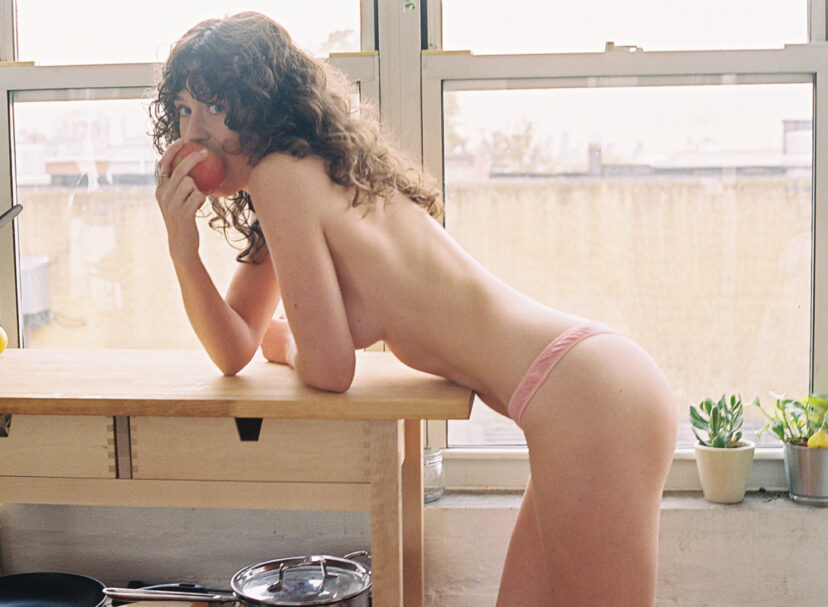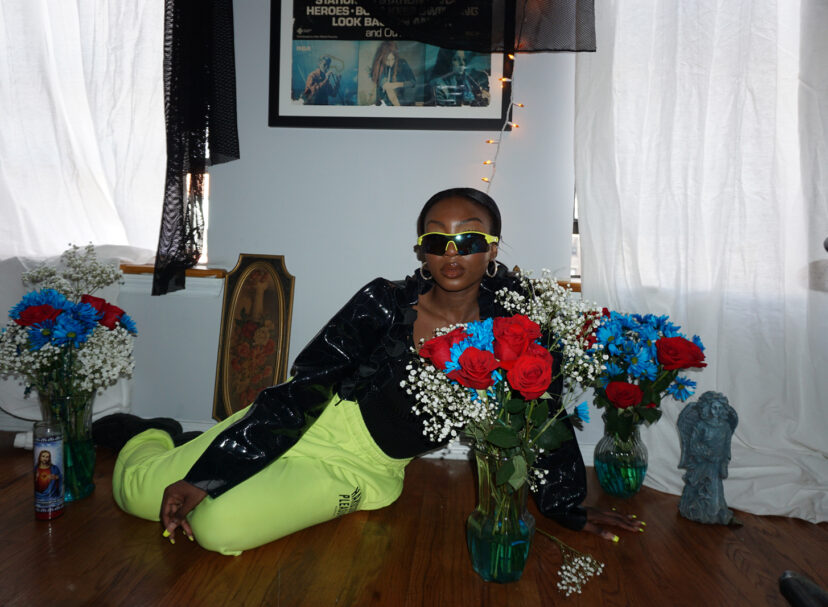Photos: Elisabet Davids
Text and Interview: Monica Uszerowicz
Since starting her company nearly by happenstance in 2007, Pamela Love’s jewelry designs have earned her numerous CFDA awards, partnerships with the likes of Zac Posen and J. Crew, and countless accolades from fans of her pieces, which draw from influences at once worldly and tremendously personal. The best inspiration of all: Love’s own story, and her ritualistic work with and love for adornment, objects, and the beautiful history therein. We spoke to her about all of these things, as well as her upcoming collection.

You’ve said previously that, long before people wore clothes, we adorned ourselves with body art and jewelry. Can you tell me about your interest in the history of body adornment and how it inspired your practice?
Since I was a little girl, I was always fascinated by the idea that people would alter their bodies in order to express themselves creatively, whether it was through piercing the ears or tattoos. I always thought it was so fascinating that someone was willing to make a change, a permanent alteration to themselves, for the sake of self-expression. I thought that was such a loyal and pure idea. This is sort of where my interest in it began—it went from there to the idea of how powerful jewelry is, as well as its role in so many cultural practices and religions.
I love that your tattoos and your jewelry seem connected, too.
They really are. Sometimes I’ll get a tattoo with each season, inspired by the collection. I started to collect tattoos that are related to the jewelry. But I think I might take a break. I think I have enough tattoos and I want to stop—it’s still sparse enough on my body to stop before I become a “tattooed person.” There’s a line and I don’t want to cross it. I’m kind of happy with where I’m at.
I like how your own history and memory are also part of your practice. In drawing on your memories—for example, your father was a surgeon and the ephemera associated with that profession seems to connect to your work—it’s as if you’re addressing your personal history in your collections.
It’s a really personal thing for me. It’s sort of the way I started the line in the first place—as a way of dealing with my father’s death when I was twenty-one. I became really interested in mourning rituals and how people communicate with the dead and celebrate the dead. I was exploring those ideas, as well as his life, through the jewelry. It was a way to cope and heal. It was very personal from the get-go, and continues to be. That idea of communicating with or celebrating people who’ve passed has always informed a lot of the designs and ideas behind the jewelry.
That renders the process of making the objects sort of like a ritual, in a way.
Exactly. And I think it was a healing ritual.



I read that you liked to find little treasures as a child, creating collections of what you’d found—you’ve always been into this.
I was always interested in collecting things. I had huge collections of shells and rocks. For some reason, I collected these marble eggs and stones. They were shaped like eggs and they came in agate and rose quartz and marble. Anytime I could find one, I would beg my mom to buy it for me. I had a giant basket of them in my room. I was really obsessed with shells and rocks as well. When I was young, I used to take a big bag when I’d go to the beach and fill it up, to the point where we had to drag it to the car, and I would make necklaces out of a lot of those objects. Even though I didn’t realize I wanted to do that for the rest of my life, I was doing it.
Where did you grow up? In a few places, right?
I grew up in Coral Springs, and my father lived in Plantation, Florida. I grew up between those places. Then I lived for a while in Orlando and then in Gainesville. I almost never go back to South Florida; when I do, I’m always surprised by how different it is. I’ve been to Coral Springs maybe once in the past ten years; my mother moved and I don’t really go back that much. It’s fun in high school! But there isn’t much to do there now.
You then went to college at NYU, so I was curious about what you did during and after. I hadn’t known until recently that you were also a stylist and art director.
I tried everything. I went to film school because I had so many different interests, and I didn’t know which one to focus on. I wanted to be a clothing designer and a painter and a writer and a musician. For me, the idea of film combined all of these things, so I could dabble. As I graduated, I was super confused about whether I wanted to go into film, work as a stylist in fashion, or be an artist. I tried working as a stylist for a little while, and then I was a painting assistant for Francesco Clemente shortly after that. It was really a saving grace—it led me to find some stability. Within that stability, I was making jewelry for myself, which led me to focus on doing that as my life.
I can see how’d look to film as a way of working with different mediums.
Yeah, but then in the end, it’s a compromise of all those mediums. Something about the that felt really frustrating and hard. I was so detail-oriented; I found jewelry-making on the side to be really therapeutic. At a certain point, I was doing it all the time. People started asking if they could buy the pieces from me, and one thing sort of led to another.
Falling into it by happenstance is one of the best ways for that to happen, I think, because it’s natural.
It’s a good way and a bad way. I didn’t have a business plan; I didn’t save up any money. If I could do it differently, I probably would’ve done it more professionally. But I was also twenty-one and I didn’t know anything.



You’ve spoken about how people will often reference a culture or subculture but have no experience with it. That’s not you—it’s clear you do your research for all your references.
For me, it’s really important to be influenced by things—cultures, places, techniques, people—but to put your own mark on it and still honor the tradition. I think that there’s a fine line you have to walk with that. You have to make sure that, in the process, you’re respecting and celebrating and, at the same time, not taking what’s not yours. That’s tricky. I’ve been so inspired by the southwest, traveling there as well as Mexico. There is a rich culture that I find so visually and spiritually inspiring. I’m heavily influenced by it, but I also have to be aware of the fact it’s someone else’s culture.
I’m influenced by other places, as well—the architecture of Morocco, for example. Some of the mosques have inspired a few of the pieces. But you have to be very careful with that—you have to show great respect for the subject matter. Even with our arrowhead pieces, we work with people who make arrowheads using the traditional technique, which is called knapping—we work with experts in that technique who are interested in keeping it alive. We’re not trying to fabricate that in another way. We really want to keep some of these traditions alive and work with people who come from those cultures, as well.
Your genuine care and interest is really obvious in the work itself.
It’s never about taking advantage—it’s about loving and worshipping and celebrating techniques and cultures that have moved you.
The Duality campaign is a little different than some of your earlier collections. Can you tell me about it?
The Duality campaign is a little more clean-feeling than many of the campaigns we’ve done in the past. I was really focused on shape and construction. I was looking a lot at bridges—particularly suspension bridges—as well as molecular construction: physics, biology. I was feeling very influenced by these structures at a microscopic level, or even smaller than that. The campaign has a bit of a cleaner feel as a result. I’m very happy with it; it’s nice to change and do different things. I’d say that Duality, more than earlier collections that celebrated spirituality, is really about celebrating architecture and science. That’s always something I’m fascinated with. I’m a huge science nerd. It’s fun to be able to explore that.


What are you working on next?
I felt like I wasn’t really done with Duality. I wanted to keep going with the ideas I had there. The problem with collections is that you’re supposed to do four a year. You design one, and then as soon as you design it, you’re supposed to design a different one. For me, it was becoming really unhealthy—I always felt like I wasn’t done with the inspiration and was forced to move onto something else. I loved this collection, but there was a lot I didn’t get to see come to fruition, and I wanted to keep working on it. I was able to take some of the designs from Duality and keep developing and changing them, as well as looking at additional inspiration. I was very focused on the Golden Gate Bridge and then, as a result, San Francisco in the 1970s, which brought another level to it. That’s sort of where I’m at, at the moment. I think it’s going to be great.
It feels like it’d be really overwhelming to keep switching focus.
It’s a lot, so it’s nice to be able to say, “I’m not done with this; I want to keep going with it.” It’s creating an ongoing dialogue with yourself, which is how I want to work in the future. Eventually, the inspiration will change, but in a more fluid, healthy way—instead of feeling so manic. It’ll just evolve naturally.



